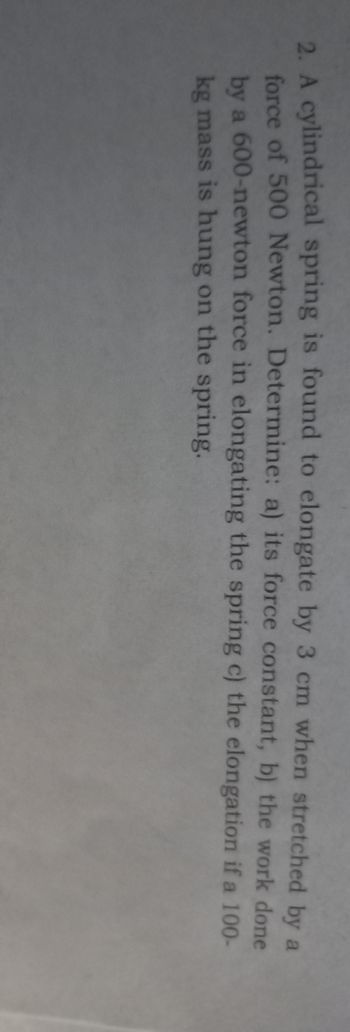
Engineering Fundamentals: An Introduction to Engineering (MindTap Course List)
5th Edition
ISBN: 9781305084766
Author: Saeed Moaveni
Publisher: Cengage Learning
expand_more
expand_more
format_list_bulleted
Question

Transcribed Image Text:2. A cylindrical spring is found to elongate by 3 cm when stretched by a
force of 500 Newton. Determine: a) its force constant, b) the work done
by a 600-newton force in elongating the spring c) the elongation if a 100-
kg mass is hung on the spring.
Expert Solution
This question has been solved!
Explore an expertly crafted, step-by-step solution for a thorough understanding of key concepts.
Step by stepSolved in 2 steps with 2 images

Knowledge Booster
Learn more about
Need a deep-dive on the concept behind this application? Look no further. Learn more about this topic, civil-engineering and related others by exploring similar questions and additional content below.Similar questions
- A structural member with a rectangular cross section as shown in the accompanying figure is used to support a load of 2500 N. What type of material do you recommend be used to carry the load safely? Base your calculations on the yield strength and a factor of safety of 2.0.arrow_forwardBourdon-type pressure gauges are used in thousands of applications. A deadweight tester is a device that is used to calibrate pressure gauges. Investigate the operation of a deadweight pressure tester. Write a brief report to discuss your findings.arrow_forwardAn astronaut has a mass of 68 kg. What is the weight of the astronaut on Earth at sea level? What are the mass and the weight of the astronaut on the Moon, and on Mars? What is the ratio of the pressure exerted by the astronauts shoe on Earth to Mars?arrow_forward
- Determine the specific gravity of the following materials: gold ( = 1208 lb/ft3), platinum ( = 1340 lb/ft3), silver ( = 654 lb/ft3), sand ( = 94.6 lb/ft3), freshly fallen snow ( = 31 lb/ft3), tar( = 75 lb/ft3), hard rubber ( = 74.4 lb/ft3).arrow_forwardRefer to Figure 10.43. A strip load of q = 1450 lb/ft2 is applied over a width with B = 48 ft. Determine the increase in vertical stress at point A located z = 21 ft below the surface. Given x = 28.8 ft. Figure 10.43arrow_forwardIn Chapter 12, we explained that the electric power consumption of various electrical components can be determined using the following power formula: P = VI = RI2 where P is power in watts, V is the voltage, I is the current in amps, and R is the resistance of the component in ohms. Plot the power consumption of an electrical component with a resistance of 145 ohms. Vary the value of the current from zero to 4 amps. Discuss and plot the change in power consumption as the function of current drawn through the component.arrow_forward
arrow_back_ios
arrow_forward_ios
Recommended textbooks for you
 Engineering Fundamentals: An Introduction to Engi...Civil EngineeringISBN:9781305084766Author:Saeed MoaveniPublisher:Cengage Learning
Engineering Fundamentals: An Introduction to Engi...Civil EngineeringISBN:9781305084766Author:Saeed MoaveniPublisher:Cengage Learning Residential Construction Academy: House Wiring (M...Civil EngineeringISBN:9781285852225Author:Gregory W FletcherPublisher:Cengage Learning
Residential Construction Academy: House Wiring (M...Civil EngineeringISBN:9781285852225Author:Gregory W FletcherPublisher:Cengage Learning
 Fundamentals of Geotechnical Engineering (MindTap...Civil EngineeringISBN:9781305635180Author:Braja M. Das, Nagaratnam SivakuganPublisher:Cengage Learning
Fundamentals of Geotechnical Engineering (MindTap...Civil EngineeringISBN:9781305635180Author:Braja M. Das, Nagaratnam SivakuganPublisher:Cengage Learning Principles of Foundation Engineering (MindTap Cou...Civil EngineeringISBN:9781337705028Author:Braja M. Das, Nagaratnam SivakuganPublisher:Cengage Learning
Principles of Foundation Engineering (MindTap Cou...Civil EngineeringISBN:9781337705028Author:Braja M. Das, Nagaratnam SivakuganPublisher:Cengage Learning

Engineering Fundamentals: An Introduction to Engi...
Civil Engineering
ISBN:9781305084766
Author:Saeed Moaveni
Publisher:Cengage Learning

Residential Construction Academy: House Wiring (M...
Civil Engineering
ISBN:9781285852225
Author:Gregory W Fletcher
Publisher:Cengage Learning


Fundamentals of Geotechnical Engineering (MindTap...
Civil Engineering
ISBN:9781305635180
Author:Braja M. Das, Nagaratnam Sivakugan
Publisher:Cengage Learning

Principles of Foundation Engineering (MindTap Cou...
Civil Engineering
ISBN:9781337705028
Author:Braja M. Das, Nagaratnam Sivakugan
Publisher:Cengage Learning
